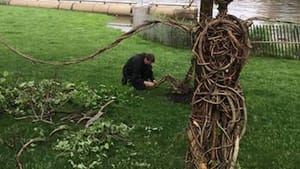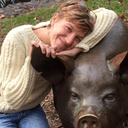Stay in the Loop
BSR publishes on a weekly schedule, with an email newsletter every Wednesday and Thursday morning. There’s no paywall, and subscribing is always free.
Art in the Open stays in the box
Art in the Open 2018

The biennial Philadelphia exhibition Art in the Open (AiO) took place — or, considering the weather, took shelter — last weekend along the Schuylkill Banks, from the South Street Bridge to the Philadelphia Waterworks. This year, the event featured 33 jury-selected artists and collaborations.
AiO offers a unique opportunity for visitors to interact with the physical process of making art. It also shows artists’ creative responses to the exhibition’s driving concept: “to develop artwork that will inspire new ways of seeing the river and the city it runs through.”
This artistic mission deserves praise (and funding, which AiO secured in full for the first time this year, with support from the William Penn Foundation). But the 2018 event was characterized more by an artistic avoidance of environment than by direct engagement with it.
Not-quite-open studios
Last week’s seemingly interminable rain left many of the selected artists hunkered underneath city bridges or hastily erected rent-a-tents. There they bravely continued creating artwork that attempted to ignore the wet conditions. The rain, however, prevailed, and even art that eschewed direct engagement with the outdoor elements was marked by shifts in practical approach.
Karen Singer, a Philadelphia relief sculptor I met underneath the JFK Bridge, gamely noted that given the wet weather, at least she didn’t have to constantly moisten her clay. Next to her, Cynthia Back, a Lansdowne collage artist working on a depiction of a bend in the river, seemed restricted by the changes necessitated by working outdoors (she usually spreads her materials out on the floor to assay them).
While some struggled with the exhibition’s outdoor location, artists with more nature-centric methods seemed equally flummoxed by the park’s urban location. Anki King, whose beautiful woven-vine sculpture still links two trees between Market Street and the JFK Bridge, was restricted by a lack of available natural materials. Bundled in a rain jacket and knee-high galoshes, she said she hadn’t initially found enough natural materials along the Schuylkill Banks to construct her piece.
After hearing that the Schuylkill Center for Environmental Education might have discarded vines and branches, she arrived to find only four bags’ worth of usable material (she usually uses six to build her forms). Nevertheless, she loaded the garbage bags into the back of an Uber and hauled them back to the Banks.

A movable canvas
Several works, however, shone against the weekend’s drab background, and the “DIY Tyvek” tarpaulin tent erected by artist Michael Konrad was one of them. Meticulously constructed out of old plastic bags fused together with an iron, the tarp provided a new context for materials often viewed floating down the Schuylkill.
On his website, Konrad describes himself as a Philadelphia-based artist interested in “reus[ing] and recreat[ing] the materials of the urban landscape into objects and shelters that anticipate and thrive within a state of environmental or social collapse.” It is both troubling and telling that a work predicated on the failing rapport between city and nature was one of the few that directly engaged with its surroundings.
Another standout was the printmaking method used by Anthony Bowers, who blanketed a section of the Schuylkill Banks Trail in charcoal before laying a large piece of muslin on top. Joggers, bikers, and a group of Segway riders along the trail left the tracks of their passage, and the finished result was a complex record of the river’s urbanite wildlife.
The weekend’s most memorable art combined this interpretation of what it means to be in an urban open space with the concept of “openness” as the public practice of art. Unfortunately, artists relying on the latter were disappointed by low attendance, and overall the event suffered.
Art from AiO 2018 will continue to be on display in galleries throughout Philadelphia thanks to the Center for Emerging Visual Artists. Right now, selected works are on display at City Hall through June 30, 2018. For viewers intrigued by the art-in-practice aspect of AiO, the Schuylkill Center for Environmental Education opened its related Wet Lab gallery on May 23, 2018. Hopefully, attendance for both will be high so such programs can continue to explore, reflect on, and eventually embrace what it truly means to have art in the open.
What, When, Where
Art in the Open 2018. May 18-20, 2018, with continuing exhibitions of related work throughout Philadelphia through 2019. Artintheopenphila.org.
Sign up for our newsletter
All of the week's new articles, all in one place. Sign up for the free weekly BSR newsletters, and don't miss a conversation.
 Helen Walsh
Helen Walsh